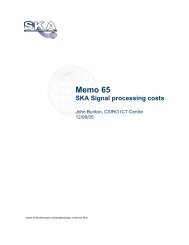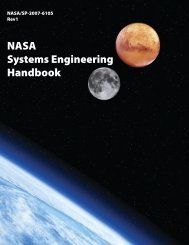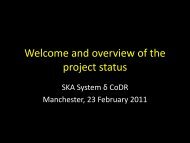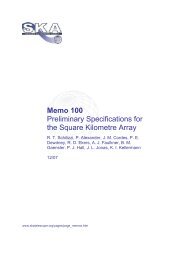Download SKA brochure pdf - The Square Kilometre Array
Download SKA brochure pdf - The Square Kilometre Array
Download SKA brochure pdf - The Square Kilometre Array
- No tags were found...
You also want an ePaper? Increase the reach of your titles
YUMPU automatically turns print PDFs into web optimized ePapers that Google loves.
<strong>The</strong> <strong>Square</strong> <strong>Kilometre</strong> <strong>Array</strong>Exploring the Universe with the world’s largest radio telescope
THE SQUARE KILOMETRE ARRAY 05<strong>The</strong> <strong>SKA</strong> project<strong>The</strong> project is led by the <strong>SKA</strong> Organisation. Basednear Manchester, UK, the <strong>SKA</strong> Organisation isco-ordinating the activities of the internationalpartners.TIMELINE– 2024FULL OPERATION– 2020-24PHASE TWO CONSTRUCTION– 2020<strong>The</strong> <strong>SKA</strong> Organisation is co-ordinating the global science andengineering activities for the world’s largest radio telescope.FULL SCIENCE OPERATIONS WITH PHASE ONE– 2016-20PHASE ONE CONSTRUCTION– 2013-15DETAILED DESIGN AND PRECONSTRUCTION PHASE– 2012SITE SELECTION– 2008-12TELESCOPE CONCEPTUAL DESIGN– 1991<strong>SKA</strong> CONCEPT<strong>The</strong> <strong>SKA</strong> will:Be the largest radio telescope in the world.Revolutionise our understanding of the Universe and the laws of fundamental physics.Be built in radio-quiet locations in Australia and Southern Africa.Have 50 times the sensitivity and 10 000 times the survey speed of current imaging instruments.Extend to at least 3 000 km from one of the central core regions.Have a life span of at least 50 years.Be continuously upgradable as computing power increases.Use new antenna technology, signal transport, signal processing and computing.As the <strong>SKA</strong> will be an aperture synthesis instrument, comprising many independent receivingelements, exciting science will be achievable before the full array is complete. Initial science resultsare expected in 2020.
What happened just after the Big Bang? Which came first - stars or galaxies?THE SQUARE KILOMETRE ARRAY 09KEY SCIENCE PROJECT:Probing the Dark Ages – the first black holes and starsx HI=0.79x HI=0.61After the Big Bang the Universe expanded andcooled, turning the hot primordial soup of particlesinto a sea of neutral gas. <strong>The</strong> process started theperiod in the evolution of the Universe referred toas the Dark Ages. As the name suggests, there wasno light in the Universe during the Dark Ages exceptfor the faint glow remaining from the Big Bang. <strong>The</strong>small density inhomogeneities left over from theperiod of fast initial expansion gradually grew underthe force of gravity, and eventually formed thefirst stars and galaxies. <strong>The</strong> light from these firstobjects slowly reionised the whole intergalacticmedium and ended the Dark Ages.option to look at the first few hundred millionyears of the evolution of the Universe and the firststars. Moreover, HI 21 cm studies of the neutralintergalactic medium may be the most importantwindow on cosmology since the discovery of thecosmic microwave background.Accreting black holes, such as those formingjust after the Dark Ages, may very well be radiosignposts of the first structures forming. Not onlyare these first supermassive black holes importantin understanding how galaxies formed, they may alsoinfluence their environment.x HI=0.42x HI=0.20Simulation snapshot of the complex geometryof reionisation. <strong>The</strong> galaxies are shown as darkdots, the ionised gas surrounding them is lightorange and the neutral gas which the <strong>SKA</strong> willsee is dark green. (Credit: I. Iliev, G. Mellema)Pockets of neutral gas (black) becomingmore ionised (white) with increasing age ofthe Universe. <strong>The</strong> cube is 100 Mpc on a side.(Credit: S. Furlanetto)Radio emission in the 21 cm line of neutral hydrogen(HI), as well as molecular lines like those from carbonmonoxide (CO) provide the best observationalwindows through which to detect directly the erawhen gas in galaxies was first turned into stars.<strong>The</strong> <strong>SKA</strong> will be the only telescope able to directlydetect this distant epoch, thus providing our best<strong>The</strong> <strong>SKA</strong> will observe the very first black holes, starsand galaxies that shaped the nascent Universeduring this time. <strong>The</strong> <strong>SKA</strong> will even be able to detectblack holes accreting during the Dark Ages. <strong>The</strong><strong>SKA</strong> will provide detailed pictures and full 3D mapsof the early cosmic web of neutral gas, the key tounderstanding the Universe that we live in today.<strong>The</strong> cosmic web of early structures. Simulated image showing theneutral hydrogen sky in the early Universe as seen by the <strong>SKA</strong>. Galaxies(bright points) form along filaments and sheets in a honey-comb fashionsurrounding vast low-density voids (dark regions). (Credit: I. Iliev, G. Mellemaand collaborators/U. Toronto)0 (ARCMIN)20100-10-20190 180V (MHz)170 1602.140.744-0.652-2.05-3.44Simulated evolution of the 21 cm emission ofneutral hydrogen from the Dark Ages throughthe epoch of reionisation. Light shows theneutral areas, dark the ionised ones. Horizontallygoing to the left we look back in time (lowerfrequency), while the vertical scale shows angleon the sky. <strong>The</strong> <strong>SKA</strong> should be able to see thisevolution in detail. (Credit: I. Iliev, G. Mellema)<strong>The</strong> giant elliptical galaxy, NGC1316 or Fornax A, shown in theradio (orange) superimposed on an optical image. <strong>The</strong> radio emissionconsists of two large radio lobes, each about 600 000 light yearsacross. <strong>The</strong> giant elliptical galaxy at the centre is cannibalising asmaller galaxy, stripping away material from it that spirals towarda super-massive black hole at the centre of its larger neighbour.(Credit: NRAO, STSci/POSS-II)
What is mysterious dark energy? How are galaxies born and how do they evolve?THE SQUARE KILOMETRE ARRAY 11KEY SCIENCE PROJECT:Galaxy evolution, cosmology and dark energyA simulated <strong>SKA</strong> observing cone depicting the complex filamentary structure of HI on cosmic scales, which encodes themysterious physics of the ‘dark Universe. Each coloured pixel in the cone represents a galaxy emitting neutral hydrogen(HI, rest-frame 21 cm) radiation. (Credit: Danail Obreschkow (Oxford) and the <strong>SKA</strong>DS Sky Simulation team)DARK ENERGY ………………………………………………………………… 73%COLD DARK MATTER ……………………………………………………… 23%NORMAL MATTER …………………………………………………………… 4%Illustration of the recent finding that the vast majority of theUniverse is filled with some unknown “dark energy” and the yet to beidentified cold “dark matter”. <strong>The</strong>re may also be a significant fraction ofhot dark matter. Only a small fraction of the Universe is made up of thenormal matter that consists of atoms.<strong>The</strong> evolution of the Universe and the formationof large scale structure appear to be governedby the strange action of a dark energy. Apartfrom the observed fact that dark energy hascaused a recent acceleration in the expansion ofthe Universe, its properties are virtually unknown.<strong>The</strong> structure of the Universe can be determinedby observing the cosmic distribution of nature’smost fundamental element - hydrogen. Hydrogenis the most abundant element in the Universe andthe raw material from which stars form. It is nowwell established that the rate of star formationin galaxies has evolved dramatically over thelast half of the Universe’s lifetime. Yet over thesame interval, the amount of neutral hydrogengas appears to have barely changed. Gaininga thorough understanding of galaxy assembly,growth, and evolution remains one of the keychallenges for astrophysics. By investigating howgalaxies turn gas into stars, the <strong>SKA</strong> will allow usto understand galaxy formation and evolution.<strong>The</strong> <strong>SKA</strong> will track how neutral hydrogen flowsinto and out of galaxies and will also be able tomonitor how gas is exchanged or lost as clustersof galaxies interact with each other. With thesedata the <strong>SKA</strong> will measure the geometry ofthe Universe, and test whether dark energyis a vacuum energy or something more exotic,perhaps providing evidence of genuinely newphysics or extra dimensions.Revealing the large-scale structure of theUniverse with the <strong>SKA</strong> will also allow thedetermination of both the neutrino mass scaleand the number of massive neutrinos, connectingastrophysics with particle physics. <strong>The</strong> <strong>SKA</strong>and its wide field of view will allow the accuratedetermination of the rate of evolution in theequation of state of dark energy with cosmictime.85MPC = 1˚85MPCZ54310 -30 Wm -2 10 -24 Wm -221<strong>SKA</strong>A SIMULATED <strong>SKA</strong>OBSERVING CONE0Simulation of the filamentary structure of the dark matter today.(Credit: Millennium Gas simulation by F. Pearce/Virgo Consortium)Combined optical (colours) and radio (contours) image showing thegravitational lens system B0631+519 where dark matter associatedwith two galaxies produces multiple images of a background source.(Credit: HST/STScI, MERLIN)
Where do we find cosmic magnets and what do they look like? How does magnetism affect star and galaxyformation? What generates these giant magnetic fields in space?THE SQUARE KILOMETRE ARRAY 13KEY SCIENCE PROJECT:<strong>The</strong> origin and evolution of cosmic magnetismMagnetic fields play important roles in the Universe.This shows magnetic field loops in the Sun’s corona in X-ray light.(Credit: TRACE mission/NASA)One of the many remarkable discoveries madeby 20th century astronomers was that stars,planets, galaxies, and even diffuse interstellargas, are all magnetic. Surprisingly, our Universeseems to be free of magnetic charges(monopoles) which would quickly destroy anymagnetic field, ensuring that magnetism islong lived.<strong>The</strong>se cosmic magnetic fields play a vital rolein controlling how stars and galaxies form, ageand evolve. In addition, this naturally occurringmagnetism regulates solar activity and spaceweather, protects the Earth from harmfulparticles, and is vital for the navigation ofbirds and other species. However, in spite ofthe importance and ubiquity of astrophysicalmagnets, we do not understand what createsthem, or how they maintain their strength overbillions of years of cosmic time.With the <strong>SKA</strong>, we can finally open the windowto this magnetic Universe. Magnetic fieldsare illuminated by electrons spiralling aroundthe field lines which emit radio waves, calledsynchrotron emission. Astronomers will alsouse the <strong>SKA</strong> to exploit an effect called Faradayrotation, in which polarised radio light froma background object is subtly changed whenit passes through a cloud of gas in whichsignificant magnetism is present.By measuring Faraday rotation in the radioemission from tens of millions of faint, distant,galaxies, the <strong>SKA</strong> will be able to detect magneticfields throughout the Universe. <strong>The</strong> resultingthree-dimensional maps of magnetism in theMilky Way, in nearby galaxies and in intergalacticspace will reveal what cosmic magnets look like,where they have came from, and what role theyhave played in the evolving Universe.<strong>The</strong> <strong>SKA</strong> will investigate cosmicmagnetism by observing Faraday rotationof polarised radio waves.Two possible sourcesfor the intergalacticmagnetic field are thejets in Active GalacticNuclei (AGNs) and PulsarNebulae. <strong>The</strong>se imagesshow well studiedexamples of the AGNand surrounding radiogalaxy 3C353 (top) andthe Crab supernovaremnant (below) whichharbours a radio pulsar.(Credit: NRAO)Optical image ofthe spiral galaxy M51with the magneticfield determined fromradio observationssuperimposed. (Credit:Hubble Heritage/NASA/STSci, R. BECK/MPIfR)
Was Einstein right or will general relativity eventually fail? Are there still ripples in space-time from the earlyUniverse? What are the properties of black holes?THE SQUARE KILOMETRE ARRAY 17KEY SCIENCE PROJECT:Extreme tests of general relativity with pulsars and black holes<strong>The</strong> best test so far of Einstein’s theory in strong gravitational fields isprovided by the only known double pulsar system, where two pulsars orbiteach other in 145 min. (Credit: M. Kramer)Pulsar orbiting a black hole.Einstein’s theory of general relativity has passedall tests with flying colours, so far. But, it maystill not be the last word in our understandingof nature’s most fundamental force - gravity.Scientists around the world are struggling to finda theory of quantum gravity which would combinegravitation with the bizarre world of quantumphysics.We can confront Einstein’s predictions and thoseof other theories of gravity experimentally byexploiting the Universe’s best clocks - pulsars.<strong>The</strong> <strong>SKA</strong> will discover tens of thousands of them,some of which will orbit stellar-sized and supermassiveblack holes. <strong>The</strong>se systems can be used toput Einstein’s theories to the most extreme testever, in particular general relativity’s descriptionof black holes.Most theories of gravity also predict ripples inspace-time which propagate through the Universeas gravitational waves. While pulsars provide theonly evidence for the existence of gravitationalwaves so far, they do not only produce thembut observations of pulsars can also lead tothe detection of gravitational waves. Usingpulsars, the <strong>SKA</strong> will act as a huge gravitationalwave detector, discovering and studying spacetimeripples left over from the early Universefrom exotic phenomena like cosmic strings ormerging super-massive black holes. <strong>The</strong> <strong>SKA</strong> willbe sensitive to nano-Hz frequencies which aremuch lower than those probed by ground-baseddetectors such as the Laser InterferometerGravitational-wave Observatory (LIGO) orPulsars discovered and monitored with the <strong>SKA</strong> will act like a cosmicgravitational wave detector, allowing the study of ripples in the fabric of spacetimethat propagate at ultra-low frequencies. (Credit: D. Champion, M. Kramer)planned space-based detectors like the LaserInterferometer Space Antenna (LISA).Pulsars orbiting black holes will testEinstein’s description of these enigmaticobjects to the extreme. (Credit: M. Kramer)
THE SQUARE KILOMETRE ARRAY 19Exploration of the unknownPutting technology to the testCan we predict everything in the Universe on the basis of what we knownow? What else will we discover when exploring the cosmic frontier?<strong>The</strong> <strong>SKA</strong> is a tool for as-yet-unborn users and musttherefore be a versatile, multi purpose instrumentwith flexibility that allows us to expect theunexpected.Radio astronomy was responsible for many of thefundamental discoveries in physics and astrophysicsin the last century.<strong>The</strong> list is long and includes:<strong>The</strong> cosmic microwave backgroundQuasarsPulsarsGravitational lensesMasersInterstellar molecules<strong>The</strong> first extrasolar planetsGalactic magnetic fieldsMany of the discoveries happened unexpectedly, sowe should be prepared for the possibility. However,the scientific challenges outlined in previous pagesare today’s most exciting problems - will they stillbe the outstanding problems that will confrontastronomers and humankind in the period 2020 to2050 and beyond, when the <strong>SKA</strong> will be in its mostproductive years? If history is any example, theexcitement of the <strong>SKA</strong> may not arise out of currentquestions, but from new questions that will beraised by the new types of observations that the<strong>SKA</strong> will permit.<strong>The</strong> unique sensitivity, multiple independent views ofthe sky, and the extremely large field-of-view makethe <strong>SKA</strong> a discovery machine. We cannot predictwhat we will find, but we know it will surprise us.Cosmic explosionsof unknown type maybe detectable as radiosignals with the <strong>SKA</strong>.(Credit: NASA)Optical fibres will be essential to transport the huge amount ofdata to the central <strong>SKA</strong> processor node. (Credit: Wikimedia Commons)<strong>The</strong> <strong>SKA</strong> - a technological and engineering challenge<strong>The</strong> <strong>SKA</strong> demands new approaches to radio telescopedesign. <strong>The</strong> path to the <strong>SKA</strong> involves mass producinglow cost antennas and using programmable signalprocessing engines as well as addressing thechallenge of transporting high data rates acrosslarge distances.After undergoing fast, high resolution sampling upto 160 Gbit/sec of data will be transmitted fromeach dish to a central processor. Data transportfrom the dishes alone will produce ten times thecurrent global internet traffic. <strong>The</strong> use of wide fieldof view expansion technologies could increase totaldata rates for the <strong>SKA</strong> to many petabits (10 15 ) persecond of data, which represents over 100 times theinternet traffic data rates today.Processing and post-processing will requireexascale central computing engines (10 18 operationsper second). <strong>The</strong> <strong>SKA</strong> will also stretch algorithmdevelopment in two vital areas. Faster and betterways will be needed to make the high dynamic range(106:1) images central to <strong>SKA</strong> science driversNew technology and progress in fundamentalengineering science are both required.Areas of particular relevance include:Low cost collecting areaLow noise, highly integrated, receiversPhased array antenna technologyWideband optical fibre signal transport systemsFast, high resolution, analogue-to-digitalconvertersHigh performance computing enginesData storage and innovative retrieval technologiesand effective radio interference (RFI) mitigationalgorithms will also be required.Pushing the instrument in the direction of a softwaretelescope allows designers to take advantage ofMoore’s law for digital hardware - processing powerdoubles every 18 months.Image of the cosmicmicrowave backgroundradiation (CMB)anisotropy. (Credit:WMAP/NASA))Data transport from the dishes will produce ten times the current global internet traffic.
Pivotal <strong>SKA</strong> technology is beingdemonstrated with a suiteof precursor and pathfindertelescopes and design studies by<strong>SKA</strong> groups around the world.Pivotal <strong>SKA</strong> technology is being demonstratedby <strong>SKA</strong> groups around the world with a suiteof precursor and pathfinder telescopes, anddesign studies. <strong>The</strong> <strong>SKA</strong> project is building onTHE SQUARE KILOMETRE ARRAY 21Precursors, pathfinders and design studiesthe experience gained to develop innovativetechnologies, models and operationalstrategies suitable for the <strong>SKA</strong> telescope.<strong>The</strong> Australian <strong>SKA</strong> precursor A<strong>SKA</strong>P.(Credit: Rob Millenaar)<strong>The</strong> South African <strong>SKA</strong> precursor demonstratorKAT-7. (Credit: Dr Nadeem Oozeer)Examples of <strong>SKA</strong> precursor andpathfinder instruments. Above: Arecibo(Credit: NAIC Arecibo Observatory a facility ofthe NSF); top right: <strong>The</strong> Murchison Widefield<strong>Array</strong> (MWA) (Credit: Dr Natasha Hurley-Walker, ICRAR); middle right: <strong>The</strong> internationalLOFAR (low frequency array) telescope (Credit:Top-Foto Assen); right: <strong>The</strong> Very Large <strong>Array</strong>(VLA). <strong>The</strong> Expanded Very Large <strong>Array</strong> (EVLA)project is an <strong>SKA</strong> pathfinder project (Credit:NRAO AUI, Bob Tetro); far right: <strong>The</strong> ElectronicMulti Beam Radio Astronomy Concept(EMBRACE) (Credit: ASTRON).
THE SQUARE KILOMETRE ARRAY 23<strong>SKA</strong> location<strong>The</strong> sitesOn 25th May 2012 the members of the <strong>SKA</strong> Organisation agreed on a dual siteimplementation for the <strong>Square</strong> <strong>Kilometre</strong> <strong>Array</strong> telescope.<strong>The</strong> A<strong>SKA</strong>P and MeerKAT precursor telescopes in Australia and South Africawill be integrated into phase one of the <strong>SKA</strong>, building on their unique sciencecapabilities.<strong>The</strong> <strong>SKA</strong> will be constructed in two phases:Phase one190 <strong>SKA</strong> dishes and 64 MeerKAT dishes equipped with single pixel feeds will belocated in South Africa (<strong>SKA</strong>1 dish mid).South AfricaAustralia60 <strong>SKA</strong> dishes and 36 A<strong>SKA</strong>P dishes equipped with phased array feeds will belocated in Australia (<strong>SKA</strong>1 dish survey).50 stations of low frequency aperture array antennas, with about 10 000antennas per station, will be located in Australia (<strong>SKA</strong>1 AA low).Phase two<strong>The</strong> dish array will be extended to about 3 000 dishes with a maximumseparation of 3 000 km across Southern Africa (<strong>SKA</strong>2 dish mid).<strong>The</strong> low frequency aperture arrays will be extended to 250 stations in Australia(<strong>SKA</strong>2 AA low).A new component comprising 250 mid frequency aperture array stations will belocated in South Africa (<strong>SKA</strong>2 AA mid).
Much of the <strong>SKA</strong> design challenge lies intransporting high data rates across largedistances.<strong>SKA</strong> and industry<strong>The</strong> <strong>SKA</strong>: a science and engineering partnershipTHE SQUARE KILOMETRE ARRAY 25Radio astronomy provides a demandingyet open, development and testenvironment for state-of-the-artdevices, information and communicationtechnology, high performancecomputing and software.Construction of the <strong>SKA</strong> over a sevenyear period is equivalent to buildingand commissioning a 100 m radiotelescope every 20 days – a task beyondthe experience of the astronomycommunity. Large scale industryinvolvement will therefore be necessary.Even before the construction phase,many of the R&D programs neededfor <strong>SKA</strong> demonstrators requireindustry experience, especially in crucialareas such as economic mass production, system engineering and mega-scale projectmanagement.<strong>The</strong> international <strong>SKA</strong> project, and its associated national programs, welcome interestfrom potential industry collaborators. Joint research and development is viewed as ashared-risk endeavour with the potential for exploitation of intellectual property.Advantages of industrycollaboration beyondcommercial contracts:Potential for early involvementin a project spanning a rangeof engineering and computingdisciplines.<strong>The</strong> ability to perfect leadingedge technologies and productsin association with the usersof a technologically demandingapplication.Increased visibility of beingassociated with an innovativeinternational mega-science project.<strong>The</strong> ability to generate and shareinformation with R&D partners inan open environment.<strong>The</strong> opportunity to interact withcreative professionals in a highlyimaginative project.Artist’s impression of the <strong>SKA</strong> layout on the ground in the centralcore regions.(Credit: <strong>SKA</strong> Community, C. Walsh)
THE SQUARE KILOMETRE ARRAY 27<strong>The</strong> design, construction and operation of the <strong>SKA</strong> will impact skillsdevelopment in science, engineering and in associated industries,not only in the host countries but in all countries involved.Beyond astronomy<strong>The</strong> <strong>SKA</strong> will deliver benefits beyond astronomy<strong>The</strong> <strong>SKA</strong> is driving technology development in antennas, data transport, softwareand computing, and power. Spin off innovations in this area will benefit othersystems that process large volumes of data from geographically dispersedsources. Systems that carry out high speed detection and analysis could alsobenefit intelligent surveillance for the recognition of faces in a crowd, weatherand traffic monitoring and monitoring of financial and retail markets.<strong>The</strong> energy requirements of the <strong>SKA</strong> present an opportunity to acceleratetechnology development in scalable renewable energy generation, distribution,storage and demand reduction.<strong>The</strong> <strong>SKA</strong> project offers an environment in which governments, industry andresearch organisations can work together in a global partnership with amutually beneficial common goal.<strong>The</strong> <strong>SKA</strong> offers an environment in which governments, industry and researchgroups can work together in a global partnership with a mutually beneficialcommon goal. <strong>The</strong> influence of the <strong>SKA</strong> extends beyond radio astronomy. <strong>The</strong> projecthas the potential to provide longstanding human capital development andemployment benefits. <strong>The</strong> design, construction and operation of the <strong>SKA</strong> will impactskills development, employment and economic growth in science, engineering andassociated industries, not only in the host countries but in all partner countries.
Artist’s impression of the low frequencyaperture arrays to be built in Australia.Artist’s impression of the <strong>SKA</strong> dishesthat will extend across Australia andSouthern Africa.<strong>SKA</strong> antennas require innovative designsolutions to meet the requirements of the keyscience projects.Artist’s impression Artist’s impression of the <strong>SKA</strong> of layout the mid on frequency theground. aperture arrays to be built in South Africa.
<strong>SKA</strong> OrganisationJodrell Bank Observatory | Lower Withington | Macclesfield | Cheshire | SK11 9DL | UKT +44 (0)161 306 9600 | www.skatelescope.orgProduced by the <strong>SKA</strong> Organisation – Revised January 2013
















